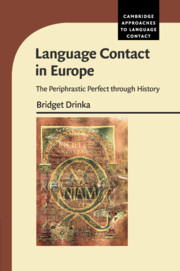Book contents
- Frontmatter
- Contents
- Series Editor's Foreword
- Acknowledgments
- Abbreviations, Based on the Leipzig Glossing Rules
- 1 Language Contact in Europe: The Periphrastic Perfect through History
- 2 Languages in Contact, Areal Linguistics, and the Perfect
- 3 The Perfect as a Category
- 4 Sources of the Perfect in Indo- European
- 5 The Periphrastic Perfect in Greek
- 6 The Periphrastic Perfect in Latin
- 7 The Charlemagne Sprachbund and the Periphrastic Perfects
- 8 The Core and Peripheral Features of the Romance Languages
- 9 The Early Development of the Perfect in the Germanic Languages
- 10 The Semantic Shift of Anterior to Preterite
- 11 The Balkan Perfects: Grammaticalization and Contact
- 12 Byzantium, Orthodoxy, and Old Church Slavonic
- 13 The l- perfect in North Slavic
- 14 Updating the Notion of Sprachbund: New Resultatives and the Circum- Baltic “Stratifi ed Convergence Zone”
- 15 The have Resultative in North Slavic and Baltic
- 16 Conclusions
- Notes
- Bibliography
- Index
3 - The Perfect as a Category
Published online by Cambridge University Press: 23 February 2017
- Frontmatter
- Contents
- Series Editor's Foreword
- Acknowledgments
- Abbreviations, Based on the Leipzig Glossing Rules
- 1 Language Contact in Europe: The Periphrastic Perfect through History
- 2 Languages in Contact, Areal Linguistics, and the Perfect
- 3 The Perfect as a Category
- 4 Sources of the Perfect in Indo- European
- 5 The Periphrastic Perfect in Greek
- 6 The Periphrastic Perfect in Latin
- 7 The Charlemagne Sprachbund and the Periphrastic Perfects
- 8 The Core and Peripheral Features of the Romance Languages
- 9 The Early Development of the Perfect in the Germanic Languages
- 10 The Semantic Shift of Anterior to Preterite
- 11 The Balkan Perfects: Grammaticalization and Contact
- 12 Byzantium, Orthodoxy, and Old Church Slavonic
- 13 The l- perfect in North Slavic
- 14 Updating the Notion of Sprachbund: New Resultatives and the Circum- Baltic “Stratifi ed Convergence Zone”
- 15 The have Resultative in North Slavic and Baltic
- 16 Conclusions
- Notes
- Bibliography
- Index
Summary
How universal is the PERFECT category? Should we, with Bybee and Dahl (1989) and Bybee, Perkins, and Pagliuca (1994), call this category a “gram,” a basic construct found widely in the languages of the world, expressing a fundamental semantic value? Or have we created an expectation that such a category exists because it is part of the temporal-aspectual repertoire of European languages? Are there predictable paths of grammaticalization that perfects tend to follow, or should these be regarded as tendencies, to be triggered by more immediate motivations such as sociolinguistic pressures?
Jacob (1994: 62), in his analysis of the perfects of Europe and of the languages of the world, suggests that it is the inner consistency (“innere Kohärenz”) of the formation of this construction across time and space, especially its persistently recurring uniformity (“immerwiederkehrende Gleichförmigkeit”) in various epochs – in Hittite as well as in Late Latin and Romance – that demonstrates that universal, cyclical processes are in operation and that language contact is thus not a prime factor in the development of the perfects of Europe. To what extent is Jacob justified in claiming “innere Kohärenz” in the formation of the periphrastic perfects of the languages of the world, across time and space? In this chapter, we attempt to answer this question by examining the perfect category from a cross-linguistic perspective, to determine whether it should be regarded as universal or not. In the course of this examination, we assess a number of claims concerning the formation and grammaticalization of the category, especially with regard to the “hodological” (“path-oriented”) approach of studies like that of Bybee et al. (1994).
What the arguments and evidence presented here will reveal is that the perfect should not, in fact, be regarded as a semantically unified, universal category, but that it is better seen as representing an array of related semantic features (CURRENT RELEVANCE, RESULTATITIVE, COMPLETIVE, etc.), available for incorporation into language-specific morphosyntactic configurations. With Anderson (1982), Li, Thompson, and Thompson (1982), Bisang (2004), Wiemer (2004), McFadden and Alexiadou (2010), and others, I claim that it is not so much the meta-category of PERFECT that should be regarded as universal, but rather that it is the more minute, closely related semantic or pragmatic properties that speakers use to construct perfects and related structures according to the cognitive and social pressures they encounter that should be so viewed.
- Type
- Chapter
- Information
- Language Contact in EuropeThe Periphrastic Perfect through History, pp. 46 - 72Publisher: Cambridge University PressPrint publication year: 2017



